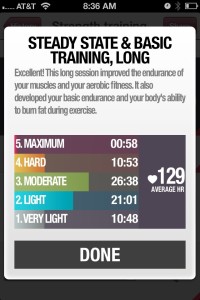 Hey guys- unless you’ve been living under a rock, you’ve been seeing me talk about using heart rate based conditioning to dictate some parameters of your work and rest. And while I do love to write, Scott Tribby reached out to me and offered to write a guest blog about just that!
Hey guys- unless you’ve been living under a rock, you’ve been seeing me talk about using heart rate based conditioning to dictate some parameters of your work and rest. And while I do love to write, Scott Tribby reached out to me and offered to write a guest blog about just that!
[Ranfone Training is located in Hamden, CT. Check out their website here: http://ranfonetrainingsystems.com/]
Scott just finished an initial four-week conditioning program that I wrote for him- but I’ll let him tell you all about that…
For many of us in the sports performance and strength/conditioning field, summer is the busiest time of the year. This is the time when most athletes have an appreciable amount of time off where they can focus on improving any number of qualities needed to increase performance. It’s no different for us at Ranfone Training Systems, as our client-base is largely high school and college level athletes. This being the case, summer is a time that, as a Coach, you put your own training on the back burner so that you can focus all of your energy on the kids and their goals (the sheer number of clients and hours during the summer makes trying to focus on both unrealistic, and would be a disservice to our clients).
Being unable to train does not mean that I cease all activity and become your typical SWM (Soft White Male), however. I take this opportunity to both PRACTICE and PLAY, as well as trying to maintain a base level of strength. Practice is based around whatever movement and/or skill I feel the need to improve at, whereas play is just that: randomized activities centered around having fun and getting off my ass and moving. To be able to play effectively at a higher intensity/level though, one must have a conditioning base from which to call upon. This is where my friend and colleague, Coach Chris Merritt, comes in… Who better to set me up on a conditioning program than the guy who prepares UFC fighter, Dustin Pague, to step into the Octagon in the best shape of his life? Plus, it’s always great to see how your peers design and implement programming (and I was just being lazy…).
Chris graciously accepted the task, and after discussing specific parameters, had a program ready for me in just a few days. The rough details of the program were as follows:
- 2 days/week with at least one day in between (I was also lifting 2 days as well)
- each session was to be kept below 30min, especially since I ride my bike 6mi to work at an average HR of 120-30 for 25-30min, so already getting a significant aerobic warmup
- the work should focus on higher intensity zones, as I get plenty of lower to medium intensity work riding the bike, jogging, hiking, etc
In order to have some objective data with which to track progress, Chris designed part of the program to revolve around HR (heart rate) levels. Each day had a section that dictated either the desired HR level to be reached during an activity, OR the desired HR level to be achieved before resuming activity. The only data that I recorded was the time it took for my HR to drop in between specific sets (trying to focus on recording too much data while executing the exercises is just too impractical). The highest I’ve ever witnessed my HR reaching recently is 189 during a 20 minute threshold test on the bike, over 6 months ago (a horrible 20 mins of my life…). I decided to use this as my max HR when calculating percentages for the programmed days.
Each conditioning session began with quick pairing of medball throws and “core” work, enough to get everything fired up and ready to work. The “meat” of the session followed: a barbell complex on Day 1 and a 3-exercise circuit on Day 2. The parameters for Day 1 dictated that I rest in between each barbell complex as long as it took to drop to 60% of max HR before resuming (approx 125bpm)…. but here’s the catch: I was to practice recovery breathing while doing so, inhaling and exhaling for an even number of steps while slowly walking. Bottom line- this sucked. I’ve always had breathing/diaphragm issues, so this was extremely difficult for me, 3 steps each was as high as I was able to achieve. On Day 2, I was to perform each exercise in the circuit until I reached 85-90% of max HR (approx. 165-170) and then rest 30 sec before proceeding to the next exercise (resting 2 min after completion of the entire circuit). Each day ended with some form of sled drag or push.
RESULTS
Here are the Day 1 barbell complex rest times to 60% HR:
- Week 1: set 1-75s, set 2-90s, set 3-90s
- Week 2: set 1-65s, set 2-75s, set 3-75s
- Week 3: set 1-55s, set 2-60s, set 3-70s, set 4-80s
- Week 4: set 1-55s, set 2-65s
For the Day 2 exercise circuit, I had to increase the rest from 30s to 45s, as I found that my HR barely budged within the initial 30. If I simply waited that extra 10-15s my HR would drop 5-10bpm, allowing me to execute the next exercise without having to stop 5s later because I’d already reached the target zone. Overall, I feel practicing the recovery breathing hindered my ability to lower my HR, but I know that in the long run it will reap benefits.
[Not from Chris: These scheduled recovery breathing drills, “breathing ladders,” are from the great Steve Maxwell- taught to me by Todd Bumgardner]
One other objective piece of data involved HRV (Heart Rate Variability). I’ve been measuring my HRV with the BioForce HRV system for almost a year now, and find it a valuable tool in evaluating long term training effects and trends. For this last 4-week conditioning program I had a positive upward trend in my HRV of +3, another indicator that my body was adapting to the imposed demands.
LOOKING FORWARD
Chris and I discussed all of these results at length, and the next 4-week phase will incorporate more of the same type of stuff, but with more chances to record objective data in order to accurately gauge progress. We both feel that the more instances there are to track HR before, during, in between, and after exercises, the better we’ll be able to predict outcomes and program accordingly.
Before you go, an online client of mine, Brittany Shearer, happens to run a fitness blog about all things health, fitness, and personal development- especially as it pertains to women. Well, I had no idea she was doing this today, but the timing couldn’t be better. She dropped a blog post about her new-found love with the Polar H7 and Polar Beat App.
 Why I Love My Polar H7
Why I Love My Polar H7
– by Brittany Shearer
(4415)
Latest posts by Chris Merritt (see all)
- Why Your Favorite Instagram Model’s Butt Program is a Waste of Time - 2017/08/30
- The ABC’s of the Kettlebell Swing - 2017/08/23
- I’m New to the Gym, What Should I Do? - 2017/08/16
